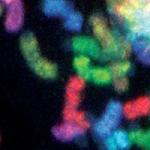
Research Topics
Functional Genomics of Cancer
One of the major problems in cancer biology is to define the aberrant pattern of gene expression in tumor cells and to relate this pattern to specific genomic alterations that occur during tumorigenesis. To address this issue, a powerful technology, DNA microarray hybridization, is being applied to analyze the consequences of chromosome anomalies at the level of gene expression. In parallel, DNA can be analyzed in the same fashion, providing a genome wide high-resolution view of copy number change. Recent advances allow additional dimensions of genome function to be profiled. These include micro RNAs, single nucleotide polymorphisms (SNPs), methylation, chromatin structure, DNAse hypersensitive sites, and transcription factor binding. The ultimate goal of our research is integrated, genome wide analysis at multiple levels of genome structure and function. In this way, it is proving possible to:
- profile individual diseases,
- determine the consequences of a given genetic alteration on gene expression, and
- identify lists of candidate genes involved in disease initiation and progression.
In addition to studies of cancer samples and somatic cells from patients with inherited disease, this technology is now being applied in model systems carrying alterations in tumor-specific genes affected by translocation, activating mutation, amplification, or deletion, and in models that have distinct biological properties such as metastasis or responsiveness to hormones. Information obtained from model systems is then integrated with gene expression profiles derived from the statistical analysis of expression data from tissue specimens. We plan to obtain detailed genomic profiles leading to the identification of genes, pathways, and mechanisms that are important in the development of cancer and that can be used in a translational context to advance the diagnosis, prognosis, and therapy of cancer. These technologies are being applied to sarcomas, breast cancer, lymphoma, gastrointestinal cancers, melanoma, and hematologic disorders.
Molecular profiling technologies. A number of technologies are applied in parallel to determine the molecular profile of a given biospecimen. The majority of these technologies currently use microarray-based methods. Several types of microarray are used for various purposes, but the predominant current technical approaches use synthetic oligonucleotides bound to a solid support and interrogated with labeled nucleic acids prepared from the biospecimen of interest. The power of this approach in the current embodiment of this technology is based largely on the direct connection between known genome sequence and the design of microarrays completely controlled by computational means. This allows the investigator to construct arrays of arbitrary design tailored specifically to the desired analysis and to adjust the resolution of the arrays to a remarkably fine level. Thus, for example, it is now possible to determine the expression of mRNAs exon-by-exon and to observe changes in gene copy number (amplification or deletion) at better than single gene resolution.
Fluorescent probes prepared from any cell or tissue source of interest are then hybridized to these arrays, providing a large-scale, high-resolution view of the genome. Our recent efforts have applied this technology to pediatric cancers, adult sarcomas, lymphoma, melanoma, gastrointestinal tumors, breast cancers, and hematologic disease. Currently, we are focused on transitioning as many assays as possible to minute samples (such as may typically be collected in the course of routine clinical care) and formalin-fixed paraffin-embedded (FFPE) specimens. The ability to work with FFPE samples is particularly important when one considers the potential to transition discoveries made in the course of this work to clinical care, where FFPE-based methods are the standard method of stabilizing biospecimens in the clinical laboratory. Recently, in collaboration with Illumina, we have obtained excellent data using small FFPE samples for gene copy number (i.e., comparative genome hybridization, CGH), SNPs, and methylation. Expression can also be studied in FFPE, but primarily with sub-genomic samples of candidate genes. Importantly, we have demonstrated that it is possible to determine the methylation status of more than 1500 CpGs in parallel on hundreds of samples, with results that match those obtained from frozen specimens. This opens up the vast existing archives of FFPE samples to investigation. Our proof-of-principle study compared follicular lymphoma to follicular hyperplasia and identified dozens of markers that robustly distinguish these two entities.
Osteosarcoma profiling. Our laboratory has had a longstanding interest in sarcoma biology and, recently, we have been applying these technologies to the pediatric bone tumor, osteosarcoma. We have successfully identified the high-resolution gene expression, gene copy number, and SNP profile of osteosarcoma. This work demonstrates a pattern of recurring copy number changes that are apparent, despite the highly chaotic nature of the osteosarcoma genome. In addition, it has been possible to demonstrate that copy number has a profound impact on gene expression in osteosarcoma. This pattern also suggests a number of candidate genes for further investigation. To gain a comparative genomics perspective on this disease, we have also investigated the gene expression pattern of canine osteosarcoma, and plan to take advantage of the similarities between human and canine disease to refine our understanding of this tumor.
Melanoma profiling. In melanoma, we are primarily focused on profiling its progenitor cell, the melanocyte in a mouse model. In collaboration with Glenn Merlino (Laboratory of Cancer Biology and Genetics, CCR) and Ed DeFabo (George Washington University), we are investigating the gene expression program of normal melanocytes in murine development using a system that specifically tags melanocytes and allows them to be purified from mouse skin by flow cytometry. This system allows us to investigate the effect of the major melanoma carcinogen, ultraviolet (UV), light on melanocyte development. Using sensitive microarray technologies, we have been able, for the first time, to observe the in vivo effect of UV radiation on melanocytes. These results are providing unprecedented insight into melanocyte development and promise to advance our understanding of UV carcinogenesis.
Breast cancer profiling. In breast cancer, we have been particularly interested in the problem of ductal carcinoma in situ (DCIS). DCIS is readily diagnosed by mammography, and may represent disease which carries little long-term risk to the patient or the early presentation of an aggressive cancer. However, pathologists have a great deal of difficulty grading DCIS and, as a result, clinicians have difficulty stratifying these patients to appropriately intense therapy. In collaboration with Rosemary Balleine (Westmead Hospital, Sydney, Australia), we have profiled microdissected DCIS lesions from specimens in which invasive cancer was associated with the DCIS. Using the grade of the invasive cancer to index the samples, we have been able to develop a gene expression classifier that can cleanly separate low-grade from high-grade DCIS. We are currently developing a multiplex gene expression assay that can be applied to FFPE DCIS samples. After validation and refinement, this assay has the potential to be applied to prospective samples and may have a substantial impact on the diagnosis and management of DCIS.
Also in the breast cancer field, we have developed high-resolution gene expression and gene copy number data, which has led to the emergence of several candidate genes that are now under investigation in our laboratory. One gene that we identified by expression profiling is GATA-3, a transcription factor which is associated with estrogen receptor-positive breast cancer. We have suspected that GATA-3 is an important developmental regulator in this system, and recent studies by others in mouse models have confirmed this hypothesis. To determine how GATA-3 regulates gene expression, we carried out whole genome transcription factor localization studies using chromatin immunoprecipitation in breast cancer cells. Our results establish a functional inter-relation between estrogen receptor and GATA-3 and provide insight into the interplay between mammary epithelial development and cancer. To follow up on candidate genes identified by our profiling studies, we are using RNA interference to silence panels of candidate genes coupled with phenotypic endpoints that identify the genes responsible for tumor growth.
Technology development. Some of the studies described above overlap with the technology development aspects of our work. For example, in collaboration with Agilent Technologies, we have pushed the expression and copy number analysis of a region known as chromosome 8p, which is frequently amplified in breast cancer, to the highest possible resolution using tiling path arrays. These studies have allowed us to map this region in breast cancer definitively and to identify conclusively the 8p genes that are active in breast cancers. We have used similar technology to map regions of gene amplification on other chromosomes, to clone the points of rearrangement, and to identify fusion genes. We are also using similar technology to investigate the pattern of expression of microRNAs and their progenitors.
Selected Publications
- Chaisaingmongkol J, Budhu A, Dang H, Rabibhadana S, Pupacdi B, Kwon SM, Forgues M, Pomyen Y, Bhudhisawasdi V, Lertprasertsuke N, Chotirosniramit A, Pairojkul C, Auewarakul CU, Sricharunrat T, Phornphutkul K, Sangrajrang S, Cam M, He P, Hewitt SM, Ylaya K, Wu X, Andersen JB, Thorgeirsson SS, Waterfall JJ, Zhu YJ, Walling J, Stevenson HS, Edelman D, Meltzer PS, Loffredo CA, Hama N, Shibata T, Wiltrout RH, Harris CC, Mahidol C, Ruchirawat M, Wang XW, TIGER-LC Consortium.. Common Molecular Subtypes Among Asian Hepatocellular Carcinoma and Cholangiocarcinoma. Cancer Cell. 2017;32(1):57-70.e3.
- Killian JK, Dorssers LC, Trabert B, Gillis AJ, Cook MB, Wang Y, Waterfall JJ, Stevenson H, Smith WI Jr, Noyes N, Retnakumar P, Stoop JH, Oosterhuis JW, Meltzer PS, McGlynn KA, Looijenga LH. Imprints and DPPA3 are bypassed during pluripotency- and differentiation-coupled methylation reprogramming in testicular germ cell tumors. Genome Res. 2016;26(11):1490-1504.
- Li J, Woods SL, Healey S, Beesley J, Chen X, Lee JS, Sivakumaran H, Wayte N, Nones K, Waterfall JJ, Pearson J, Patch AM, Senz J, Ferreira MA, Kaurah P, Mackenzie R, Heravi-Moussavi A, Hansford S, Lannagan TRM, Spurdle AB, Simpson PT, da Silva L, Lakhani SR, Clouston AD, Bettington M, Grimpen F, Busuttil RA, Di Costanzo N, Boussioutas A, Jeanjean M, Chong G, Fabre A, Olschwang S, Faulkner GJ, Bellos E, Coin L, Rioux K, Bathe OF, Wen X, Martin HC, Neklason DW, Davis SR, Walker RL, Calzone KA, Avital I, Heller T, Koh C, Pineda M, Rudloff U, Quezado M, Pichurin PN, Hulick PJ, Weissman SM, Newlin A, Rubinstein WS, Sampson JE, Hamman K, Goldgar D, Poplawski N, Phillips K, Schofield L, Armstrong J, Kiraly-Borri C, Suthers GK, Huntsman DG, Foulkes WD, Carneiro F, Lindor NM, Edwards SL, French JD, Waddell N, Meltzer PS, Worthley DL, Schrader KA, Chenevix-Trench G. Point Mutations in Exon 1B of APC Reveal Gastric Adenocarcinoma and Proximal Polyposis of the Stomach as a Familial Adenomatous Polyposis Variant. Am J Hum Genet. 2016;98(5):830-842.
- Grøntved L, Waterfall JJ, Kim DW, Baek S, Sung MH, Zhao L, Park JW, Nielsen R, Walker RL, Zhu YJ, Meltzer PS, Hager GL, Cheng SY. Transcriptional activation by the thyroid hormone receptor through ligand-dependent receptor recruitment and chromatin remodelling. Nat Commun. 2015;6:7048.
- Gindin Y, Valenzuela MS, Aladjem MI, Meltzer PS, Bilke S. A chromatin structure-based model accurately predicts DNA replication timing in human cells. Mol Syst Biol. 2014;10:722.
Related Scientific Focus Areas




Molecular Biology and Biochemistry
View additional Principal Investigators in Molecular Biology and Biochemistry

This page was last updated on Friday, September 12, 2025